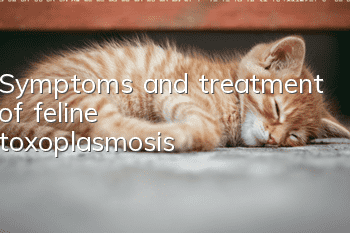Symptoms and treatment of feline toxoplasmosis

What is toxoplasmosis? Toxoplasmosis is a disease caused by infection with the tiny parasite Toxoplasma gondii. This parasite can affect all mammals, but cats are particularly important in its life cycle and transmission, and the consequences are particularly severe. Humans can also become infected, but possible adverse consequences are very rare. Therefore, if a cat is infected with this parasite, it will have serious consequences.
How common is toxoplasmosis?
This parasite has a global distribution and is more common in tropical climates. Overall, it is estimated that approximately 50% of the world's cats are infected with toxoplasmosis at some point in their lives. However, most cats show no detectable external signs of Toxoplasma gondii infection, so it is unlikely that their cat owners are aware that this has occurred.
What is the life cycle of Toxoplasma gondii?
Toxoplasma gondii is a single-cell protozoa that is so small that it can only be seen under a microscope. The life cycle is complex and includes two types of hosts, the decisive host and the intermediate host. The key differences between these types of hosts are as follows:
When Toxoplasma gondii infects a final host, they can lay eggs.
When Toxoplasma gondii infects an intermediate host, they cannot produce eggs, but they produce tissue cysts.
Cats (including wild cats, domestic cats, pet cats and stray cats) are the only animals that can determine the host, so toxoplasmosis organisms can only produce eggs in cats. All other warm-blooded animals can serve as intermediate hosts, including humans, but also the many species that provide food for cats, from farmed cattle, sheep, poultry, and pigs, to small animals such as voles, mice, and birds, to oysters and Mussels and other shellfish.
The Toxoplasma parasite cannot lay eggs in an intermediate host. Instead, the parasite forms tiny cysts in the animal's tissues (muscles and organs). These tissue cysts can infect other animals if the meat is eaten raw. The cyst remains in the host throughout the animal's life cycle and is infectious to any organism that eats the animal. The cyst is like a sac containing the active body of Toxoplasma gondii, which is called a bradyzoite. During the life cycle of Toxoplasma gondii, individual parasites transform into different stages with different names, including bradyzoites (found in tissue cysts, or cysts), sporozoites (found in oocysts), and Tachyzoites and merozoites.
How do cats, humans, and other species become infected?
Cats, humans, and other species can ingest oocysts from cat feces or by eating animal parts.Tissues ingest cysts and become infected with toxoplasmosis. Kittens can also be infected by their mother in utero or by sucking her mother's milk, but these routes of infection are rare. Adult cats and humans can also become infected after drinking unpasteurized milk from infected cows or goats.
How do infected cats spread toxoplasmosis?
After cats become infected, they shed oocysts in large numbers over a period of about two weeks. After two weeks, the cat's immune response has processed the parasite and the oocysts are no longer shed in the feces. Here's a key point: A cat that's "positive" for toxoplasmosis is actually less likely to shed oocysts. Cats are only contagious during the early stages, within 14 days of initial infection.
Importantly, oocysts transmitted through cat feces are not immediately contagious to other animals; a process called "sporulation" must occur, which takes 1 to 5 days. The significance of this fact is that fresh cat droppings are unlikely to be contagious to humans, whereas "old" cat droppings may be. Therefore, humans who may be susceptible to the adverse effects of toxoplasmosis should avoid contact with "old" cat feces. This means that the cat's litter box should be cleaned immediately.
The egg sacs are hard and can survive in the environment for months long after the feces that originally carried them has dissipated. So if a cat defecates in the soil and buries it, the oocysts will be present in the soil. If other animals ingest these oocysts, they hatch in the new host's intestines, and from there the infection spreads into the bloodstream and then to other parts of the body, creating new worms wherever they colonize. bag.
Symptoms of toxoplasmosis in cats
Most cats show no clinical signs of toxoplasmosis, but rarely symptoms such as fever, loss of appetite, weight loss, and lethargy occur, and a variety of other symptoms may occur depending on the part of the body affected. This includes lung disease, liver disease, muscle pain, inflammatory diseases affecting the eyes and brain, and swollen lymph nodes.
Symptoms of toxoplasmosis infection in humans
Healthy people usually handle a toxoplasmosis infection well, with the immune system effectively eliminating the parasite, without any signs, or perhaps just flu-like symptoms, such as a mild fever and swollen lymph nodes. However, for some people, the consequences of toxoplasmosis can be very serious. This is because their immune systems cannot effectively deal with the parasites. High-risk groups include infants, young children, the elderly, and anyone who is immunocompromised due to illness or chemotherapy. Pregnant women are also a high-risk group becauseThe risks to the fetus in the womb are also great.
Possible consequences of toxoplasmosis infection in these high-risk groups include inflammation of the brain, nervous system, and eyes, as well as miscarriage, stillbirth, and birth defects. These potentially serious consequences explain why it is so important to understand toxoplasmosis and take steps to ensure no one is at risk.
How common is toxoplasmosis in cats?
Globally, approximately 50% of the cat population has been exposed to toxoplasmosis at some stage, but it is also important to remember that cats are only contagious for two weeks after becoming infected. Therefore, the proportion of actively contagious cats is very, very low, and although it is impossible to calculate it precisely, it is more likely less than 0.1% (i.e. less than 1 in 1,000 cats). Clinical disease in cats caused by toxoplasmosis is also very rare.
How common is toxoplasmosis in humans?
There are significant geographic differences in human toxoplasmosis infection rates. Studies of toxoplasmosis antibodies suggest that in the United Kingdom, 20–30% of people will be infected, in France and Germany there is evidence that 80% of the population will be infected, and in the United States, according to the Centers for Disease Control and Prevention website According to the data, this number is about 12%. The most worrisome threat from toxoplasmosis is the risk of abortion or birth defects when pregnant women become infected. If a woman is infected with toxoplasmosis before becoming pregnant, her immune system will produce antibodies and there is no risk to her unborn baby if she is exposed to the parasite again during pregnancy. The only risk is to the infant of a pregnant woman who is exposed to toxoplasmosis for the first time during pregnancy.
Does owning a cat increase a person’s risk of contracting toxoplasmosis?
Contact with cats does not increase the risk of toxoplasmosis in humans, perhaps unexpectedly, research suggests. As mentioned above, cats will only shed toxoplasmosis eggs for two weeks after initial infection, so while it is common for cats to be "positive" for toxoplasmosis, it is very common for cats to be actively contagious to humans. rare. Most people become infected by eating raw or undercooked meat. Two danger areas that scavengers should be aware of are pregnant women carrying cat litter trays, and young children playing in gardens or sandboxes. Soil or sand that may have been contaminated by infected cat feces in the past.
Diagnosis of toxoplasmosis
Based on the symptoms listed above, if you suspect that your cat may be infected with toxoplasmosis, you should go to your local veterinarian where the following steps can be taken.
Introduce the cat’s life in detail: the veterinarian will ask you about the cat’s life and health careAll aspects of management. For example, toxoplasmosis is more common in cats that hunt, while cats that stay indoors all the time are much less likely to contract it.
Physical examination: Your veterinarian will examine your cat carefully, noting any signs of illness.
Routine blood tests: Usual blood tests, including hematology and biochemical profiles, will provide guidance on whether the cat has a specific system and how the cat's immune system is responding.
Specialized blood tests: There are many different serum titers for Toxoplasma antibodies, but importantly these are only evidence of past exposure to the organism.
Careful evaluation of different types of antibodies, as well as repeat samples to measure trends, may help identify active infection, but expert interpretation of the results is always required. Your veterinarian will work with the local Centers for Disease Control and Prevention to give you the best advice.
Fecal examination: If the cat is actively shedding oocytes, these oocytes can be detected in the feces but are rarely identified.
Histopathology: Tissue cysts (worm cysts) can be seen in samples collected by biopsy.
Polymerase chain reaction testing: PCR testing can be performed on stool, biopsy samples, cerebrospinal fluid and respiratory secretions. This is a sensitive test that can identify specific DNA evidence of toxoplasmosis.
Treatment of toxoplasmosis in cats
Most cats do not need treatment for toxoplasmosis; their immune systems can effectively deal with the infection. Cats affected by toxoplasmosis can be treated with a number of different medications, including clindamycin, trimethoprim, and pyrimethamine. These are prescription medications, so they should only be taken under the strict supervision of a veterinarian. Some are off-label, meaning they are not specifically licensed for use in treating toxoplasmosis, which is another reason they require veterinary guidance,
Tips to prevent the spread of toxoplasmosis:
If you want to minimize your cat's risk of contracting toxoplasmosis, keep them indoors and feed them only cooked or processed meat. Humans should be informed about these risk factors so that they know whether they are more susceptible to the adverse effects of toxoplasmosis infection. This includes infants, children, the elderly, and anyone with a suppressed immune system due to illness or chemotherapy. Pregnant women are also a high-risk group because the risk to the fetus in the womb is also great. People in these groups should take specific steps, including practicing good hygiene with their cats and being aware of undercooked meat in kitchens and restaurants.
Here are some ways to avoid being infected by feline toxoplasmosis:
Avoid handling the litter box,And avoid contact with cat feces.
Clean your cat’s litter box regularly with detergent and hot water
Properly dispose of cat litter, such as sealing it in a plastic bag and placing it in household waste
Empty the litter tray daily so that if oocysts happen to be in your cat’s feces, they won’t become infected
Avoid handling soil that may have been contaminated by infected cat feces at some point in the past
Wash fruits and vegetables carefully to remove all traces of soil
Don’t eat unwashed fruit
Wash your hands frequently.
Clean and wash all food preparation surfaces and utensils before and after use
Cook all meat thoroughly to kill any tissue cysts
Consider freezing fresh meat and thawing it before cooking as this can reduce the contagiousness of tissue cysts
Avoid eating raw shellfish
Conclusion:
Toxoplasmosis is a complex, tiny parasite that rarely causes serious disease in cats and people. Cat owners are no more at risk of contracting toxoplasmosis than non-cat owners. However, while you should be aware of how parasites are spread, you should take simple steps to further reduce your risk of contracting them.
- How many hours should a cat normally sleep a day?
- What causes cats to poop and vomit?
- How to train a cat to use a scratching post
- Why does a male cat still ride a female cat after being neutered?
- Teach you how to walk a cat? Cat’s outdoor exercise: walking!
- How old do kittens need to be to survive on their own?
- To train a cat, you must first understand the cat and train the cat easily!
- Causes and treatment methods for cats with excessive eye mucus!
- How often should a cat be bathed?
- What should you pay attention to in your cat’s diet?



